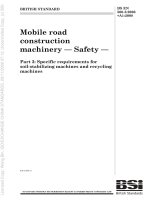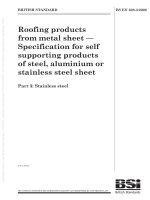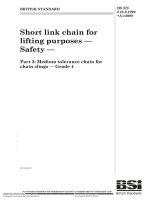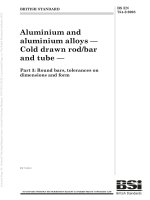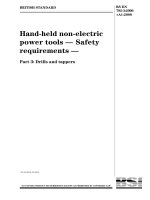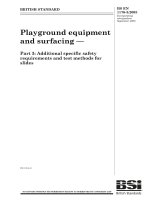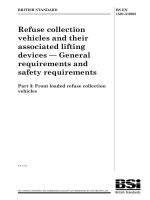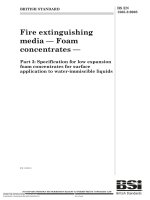Bsi bs en 61326 3 2 2008
Bạn đang xem bản rút gọn của tài liệu. Xem và tải ngay bản đầy đủ của tài liệu tại đây (2.02 MB, 42 trang )
BS EN 61326-3-2:2008
BSI British Standards
Electrical equipment for
measurement, control and
laboratory use –
EMC requirements
Part 3–2: Immunity requirements for
safety-related systems and for equipment
intended to perform safety-related functions
(functional safety) – Industrial applications with
specified electromagnetic environment
NO COPYING WITHOUT BSI PERMISSION EXCEPT AS PERMITTED BY COPYRIGHT LAW
raising standards worldwide™
BRITISH STANDARD
BS EN 61326-3-2:2008
National foreword
This British Standard is the UK implementation of EN 61326-3-2:2008. It
is identical with IEC 61326-3-2:2008. Together with BS EN 61326-1:2006,
BS EN 61326-2-1:2006, BS EN 61326-2-2:2006, BS EN 61326-2-3:2006,
BS EN 61326-2-4:2006, BS EN 61326-2-5:2006, BS EN 61326-2-6:2006
and BS EN 61326-3-1:2008, it supersedes BS EN 61326:1998 which is
withdrawn.
The UK participation in its preparation was entrusted by Technical
Committee GEL/65, Measurement and control, to Subcommittee
GEL/65/1, System considerations.
A list of organizations represented on this committee can be obtained on
request to its secretary.
This publication does not purport to include all the necessary provisions
of a contract. Users are responsible for its correct application.
© BSI 2009
ISBN 978 0 580 56351 5
ICS 25.040.40; 33.100.20
Compliance with a British Standard cannot confer immunity from
legal obligations.
This British Standard was published under the authority of the Standards
Policy and Strategy Committee on 31 January 2009.
Amendments issued since publication
Amd. No.
Date
Text affected
BS EN 61326-3-2:2008
EUROPEAN STANDARD
EN 61326-3-2
NORME EUROPÉENNE
June 2008
EUROPÄISCHE NORM
ICS 25.040.40; 33.100.20
Partially supersedes EN 61326:1997 + A1:1998 + A2:2002 + A3:2003
English version
Electrical equipment for measurement, control and laboratory use EMC requirements Part 3-2: Immunity requirements for safety-related systems
and for equipment intended to perform safety-related functions
(functional safety) Industrial applications with specified electromagnetic environment
(IEC 61326-3-2:2008)
Matériel électrique de mesure,
de commande et de laboratoire Exigences relatives à la CEM Partie 3-2: Exigences d'immunité
pour les systèmes relatifs à la sécurité
et aux matériels destinés à réaliser des
fonctions relatives à la sécurité
(sécurité fonctionnelle) Applications industrielles
dont l'environnement électromagnétique
est spécifié
(CEI 61326-3-2:2008)
Elektrische Mess-, Steuer-,
Regel- und Laborgeräte EMV-Anforderungen Teil 3-2: Störfestigkeitsanforderungen
für sicherheitsbezogene Systeme und
für Geräte, die für sicherheitsbezogene
Funktionen vorgesehen sind
(Funktionale Sicherheit) Industrielle Anwendungen in spezifizierter
elektromagnetischer Umgebung
(IEC 61326-3-2:2008)
This European Standard was approved by CENELEC on 2008-06-01. CENELEC members are bound to comply
with the CEN/CENELEC Internal Regulations which stipulate the conditions for giving this European Standard
the status of a national standard without any alteration.
Up-to-date lists and bibliographical references concerning such national standards may be obtained on
application to the Central Secretariat or to any CENELEC member.
This European Standard exists in three official versions (English, French, German). A version in any other
language made by translation under the responsibility of a CENELEC member into its own language and notified
to the Central Secretariat has the same status as the official versions.
CENELEC members are the national electrotechnical committees of Austria, Belgium, Bulgaria, Cyprus, the
Czech Republic, Denmark, Estonia, Finland, France, Germany, Greece, Hungary, Iceland, Ireland, Italy, Latvia,
Lithuania, Luxembourg, Malta, the Netherlands, Norway, Poland, Portugal, Romania, Slovakia, Slovenia, Spain,
Sweden, Switzerland and the United Kingdom.
CENELEC
European Committee for Electrotechnical Standardization
Comité Européen de Normalisation Electrotechnique
Europäisches Komitee für Elektrotechnische Normung
Central Secretariat: rue de Stassart 35, B - 1050 Brussels
© 2008 CENELEC -
All rights of exploitation in any form and by any means reserved worldwide for CENELEC members.
Ref. No. EN 61326-3-2:2008 E
BS EN 61326-3-2:2008
EN 61326-3-2:2008
-2-
Foreword
The text of document 65A/501/FDIS, future edition 1 of IEC 61326-3-2, prepared by SC 65A, System
aspects, of IEC TC 65, Industrial-process measurement, control and automation, was submitted to the
IEC-CENELEC parallel vote and was approved by CENELEC as EN 61326-3-2 on 2008-06-01.
The EN 61326 series supersedes EN 61326:1997 + corrigendum September 1998 + A1:1998 + A2:2001
+ A3:2003.
This standard is to be used in conjunction with EN 61326-1.
The following dates were fixed:
– latest date by which the EN has to be implemented
at national level by publication of an identical
national standard or by endorsement
(dop)
2009-03-01
– latest date by which the national standards conflicting
with the EN have to be withdrawn
(dow)
2011-06-01
Annex ZA has been added by CENELEC.
__________
Endorsement notice
The text of the International Standard IEC 61326-3-2:2008 was approved by CENELEC as a European
Standard without any modification.
__________
BS EN 61326-3-2:2008
-3-
EN 61326-3-2:2008
Annex ZA
(normative)
Normative references to international publications
with their corresponding European publications
The following referenced documents are indispensable for the application of this document. For dated
references, only the edition cited applies. For undated references, the latest edition of the referenced
document (including any amendments) applies.
NOTE When an international publication has been modified by common modifications, indicated by (mod), the relevant EN/HD
applies.
Publication
Year
1)
Title
EN/HD
Year
International Electrotechnical Vocabulary
(IEV) Chapter 161: Electromagnetic compatibility
-
-
IEC 60050-161
-
IEC 61000-4-2
A1
A2
1995
1998
2000
Electromagnetic compatibility (EMC) Part 4-2: Testing and measurement
techniques - Electrostatic discharge
immunity test
EN 61000-4-2
A1
A2
1995
1998
2001
IEC 61000-4-3
2006
Electromagnetic compatibility (EMC) Part 4-3: Testing and measurement
techniques - Radiated, radio-frequency,
electromagnetic field immunity test
EN 61000-4-3
2006
IEC 61000-4-4
2004
Electromagnetic compatibility (EMC) Part 4-4: Testing and measurement
techniques - Electrical fast transient/burst
immunity test
EN 61000-4-4
2004
IEC 61000-4-5
2005
Electromagnetic compatibility (EMC) Part 4-5: Testing and measurement
techniques - Surge immunity test
EN 61000-4-5
2006
IEC 61000-4-6
+ A1
+ A2
2003
2004
2006
Electromagnetic compatibility (EMC) Part 4-6: Testing and measurement
techniques - Immunity to conducted
disturbances, induced by radio-frequency
fields
EN 61000-4-6
+ corr. August
2007
2007
IEC 61000-4-8
A1
1993
2000
Electromagnetic compatibility (EMC) EN 61000-4-8
Part 4-8: Testing and measurement
A1
techniques - Power frequency magnetic field
immunity test
1993
2001
IEC 61000-4-11
2004
Electromagnetic compatibility (EMC) EN 61000-4-11
Part 4-11: Testing and measurement
techniques - Voltage dips, short interruptions
and voltage variations immunity tests
2004
IEC 61000-4-29
2000
Electromagnetic compatibility (EMC) EN 61000-4-29
Part 4-29: Testing and measurement
techniques - Voltage dips, short interruptions
and voltage variations on d.c. input power port
immunity tests
2000
IEC 61000-6-2
2005
Electromagnetic compatibility (EMC) Part 6-2: Generic standards - Immunity for
industrial environments
2005
2005
1)
Undated reference.
EN 61000-6-2
+ corr. September
BS EN 61326-3-2:2008
EN 61326-3-2:2008
-4-
Publication
Year
Title
EN/HD
Year
IEC 61326-1
2005
Electrical equipment for measurement,
control and laboratory use - EMC
requirements Part 1: General requirements
EN 61326-1
2006
IEC 61326-2-1
2005
Electrical equipment for measurement,
EN 61326-2-1
control and laboratory use - EMC
requirements Part 2-1: Particular requirements - Test
configurations, operational conditions and
performance criteria for sensitive test and
measurement equipment for EMC unprotected
applications
2006
IEC 61326-2-2
2005
Electrical equipment for measurement,
EN 61326-2-2
control and laboratory use - EMC
requirements Part 2-2: Particular requirements - Test
configurations, operational conditions and
performance criteria for portable test,
measuring and monitoring equipment used in
low-voltage distribution systems
2006
IEC 61326-2-3
2006
Electrical equipment for measurement,
control and laboratory use - EMC
requirements Part 2-3: Particular requirements - Test
configuration, operational conditions and
performance criteria for transducers with
integrated or remote signal conditioning
EN 61326-2-3
2006
IEC 61326-2-4
2006
Electrical equipment for measurement,
EN 61326-2-4
control and laboratory use - EMC
requirements Part 2-4: Particular requirements - Test
configurations, operational conditions and
performance criteria for insulation monitoring
devices according to IEC 61557-8 and for
equipment for insulation fault location
according to IEC 61557-9
2006
IEC 61326-2-5
2006
Electrical equipment for measurement,
control and laboratory use - EMC
requirements Part 2-5: Particular requirements - Test
configurations, operational conditions and
performance criteria for field devices with
interfaces according to IEC 61784-1, CP 3/2
EN 61326-2-5
2006
IEC 61326-3-1
2008
Electrical equipment for measurement,
EN 61326-3-1
control and laboratory use - EMC
requirements Part 3-1: Immunity requirements for safetyrelated systems and for equipment intended to
perform safety-related functions (functional
safety) - General industrial applications
2008
IEC 61508-2
2000
Functional safety of
EN 61508-2
electrical/electronic/programmable electronic
safety-related systems Part 2: Requirements for
electrical/electronic/programmable electronic
safety-related systems
2001
BS EN 61326-3-2:2008
-5-
EN 61326-3-2:2008
Publication
Year
Title
EN/HD
IEC 61508-4
+ corr. April
1998
1999
Functional safety of
electrical/electronic/programmable electronic EN 61508-4
safety-related systems Part 4: Definitions and abbreviations
IEC 61511-1
+ corr. November
2003
2004
Functional safety - Safety instrumented
systems for the process industry sector Part 1: Framework, definitions, system,
hardware and software requirements
ISO/IEC Guide 51
1999
Safety aspects - Guidelines for their inclusion in standards
EN 61511-1
Year
2001
2004
-
BS EN 61326-3-2:2008
This page deliberately left blank
BS EN 61326-3-2:2008
–2–
61326-3-2 © IEC:2008
CONTENTS
FOREWORD...........................................................................................................................4
INTRODUCTION.....................................................................................................................6
1
Scope ...............................................................................................................................9
2
Normative references ..................................................................................................... 10
3
Terms and definitions ..................................................................................................... 11
4
General .......................................................................................................................... 13
5
EMC test plan................................................................................................................. 14
5.1
5.2
6
General ................................................................................................................. 14
Configuration of EUT during testing ....................................................................... 14
5.2.1 General ..................................................................................................... 14
5.2.2 Composition of EUT................................................................................... 14
5.2.3 Assembly of EUT ....................................................................................... 14
5.2.4 I/O ports .................................................................................................... 15
5.2.5 Auxiliary equipment ................................................................................... 15
5.2.6 Cabling and earthing (grounding)............................................................... 15
5.3 Operation conditions of EUT during testing............................................................ 15
5.3.1 Operation modes ....................................................................................... 15
5.3.2 Environmental conditions........................................................................... 15
5.3.3 EUT software during test ........................................................................... 15
5.4 Specification of performance criteria ..................................................................... 15
5.5 Test description..................................................................................................... 15
Performance criteria ....................................................................................................... 16
7
6.1 Performance criteria A, B and C ............................................................................ 16
6.2 Performance criterion FS....................................................................................... 16
6.3 Application of the performance criterion FS ........................................................... 16
Immunity requirements ................................................................................................... 16
8
Test set-up and test philosophy for EUT with functions intended for safety
applications .................................................................................................................... 19
8.1
9
8.2
8.3
8.4
8.5
Test
Testing of safety-related systems and equipment intended to be used in
safety-related systems .......................................................................................... 19
Test philosophy for equipment intended for use in safety-related systems ............. 20
Test philosophy for safety-related systems ............................................................ 20
Test configuration.................................................................................................. 20
Monitoring ............................................................................................................. 21
results and test report ............................................................................................. 21
Annex A (informative) Evaluation of electromagnetic phenomena ........................................ 25
Annex B (informative) Details of the specified electromagnetic environment ........................ 27
Annex C (informative) Example of immunity levels in the process industry ........................... 31
Bibliography.......................................................................................................................... 32
Figure 1 – Correlation between the standards IEC 61326-1, IEC 61326-2-X,
IEC 61326-3-1 and IEC 61326-3-2 ..........................................................................................8
BS EN 61326-3-2:2008
61326-3-2 © IEC:2008
–3–
Figure 2 – Typical test set-up for equipment intended for use in a safety related system
integrated into a representative safety-related system during test ......................................... 22
Figure 3 – Typical test set-up for equipment intended for use in a safety-related system
tested stand-alone ................................................................................................................ 23
Figure 4 – Test set-up for a safety-related system ................................................................ 24
Figure B.1 – Recommended cable layouts for different categories ........................................ 28
Table 1a – Immunity test requirements for equipment intended for use in industrial
locations with specified electromagnetic environment – Enclosure port ................................. 17
Table 1b – Immunity test requirements for equipment intended for use in industrial
locations with specified electromagnetic environment – Input and output a.c. power
ports ..................................................................................................................................... 17
Table 1c – Immunity test requirements for equipment intended for use in industrial
locations with specified electromagnetic environment – Input and output d.c. power
ports ..................................................................................................................................... 18
Table 1d – Immunity test requirements for equipment intended for use in industrial
locations with specified electromagnetic environment – I/O signal/control ports ................... 18
Table 1e – Immunity test requirements for equipment intended for use in industrial
locations with specified electromagnetic environment – I/O signal/control ports
connected directly to power supply networks ....................................................................... 19
Table 1f – Immunity test requirements for equipment intended for use in industrial
locations with specified electromagnetic environment – Functional earth port ....................... 19
Table A.1 – General considerations for the application of electromagnetic phenomena
for functional safety in industrial applications with specified electromagnetic environment
(examples) ............................................................................................................................. 26
Table C.1 – Immunity test requirements for equipment intended for use in industrial
locations with a specified electromagnetic environment according to NE 21 .......................... 31
BS EN 61326-3-2:2008
–4–
61326-3-2 © IEC:2008
INTERNATIONAL ELECTROTECHNICAL COMMISSION
____________
ELECTRICAL EQUIPMENT FOR MEASUREMENT,
CONTROL AND LABORATORY USE –
EMC REQUIREMENTS –
Part 3-2: Immunity requirements for safety-related
systems and for equipment intended to perform
safety-related functions (functional safety) –
Industrial applications with specified
electromagnetic environment
FOREWORD
1) The International Electrotechnical Commission (IEC) is a worldwide organization for standardization comprising
all national electrotechnical committees (IEC National Committees). The object of IEC is to promote
international co-operation on all questions concerning standardization in the electrical and electronic fields. To
this end and in addition to other activities, IEC publishes International Standards, Technical Specifications,
Technical Reports, Publicly Available Specifications (PAS) and Guides (hereafter referred to as “IEC
Publication(s)”). Their preparation is entrusted to technical committees; any IEC National Committee interested
in the subject dealt with may participate in this preparatory work. International, governmental and nongovernmental organizations liaising with the IEC also participate in this preparation. IEC collaborates closely
with the International Organization for Standardization (ISO) in accordance with conditions determined by
agreement between the two organizations.
2) The formal decisions or agreements of IEC on technical matters express, as nearly as possible, an international
consensus of opinion on the relevant subjects since each technical committee has representation from all
interested IEC National Committees.
3) IEC Publications have the form of recommendations for international use and are accepted by IEC National
Committees in that sense. While all reasonable efforts are made to ensure that the technical content of IEC
Publications is accurate, IEC cannot be held responsible for the way in which they are used or for any
misinterpretation by any end user.
4) In order to promote international uniformity, IEC National Committees undertake to apply IEC Publications
transparently to the maximum extent possible in their national and regional publications. Any divergence
between any IEC Publication and the corresponding national or regional publication shall be clearly indicated in
the latter.
5) IEC provides no marking procedure to indicate its approval and cannot be rendered responsible for any
equipment declared to be in conformity with an IEC Publication.
6) All users should ensure that they have the latest edition of this publication.
7) No liability shall attach to IEC or its directors, employees, servants or agents including individual experts and
members of its technical committees and IEC National Committees for any personal injury, property damage or
other damage of any nature whatsoever, whether direct or indirect, or for costs (including legal fees) and
expenses arising out of the publication, use of, or reliance upon, this IEC Publication or any other IEC
Publications.
8) Attention is drawn to the Normative references cited in this publication. Use of the referenced publications is
indispensable for the correct application of this publication.
9) Attention is drawn to the possibility that some of the elements of this IEC Publication may be the subject of
patent rights. IEC shall not be held responsible for identifying any or all such patent rights.
International Standard IEC 61326-3-2 has been prepared by subcommittee 65A: System
aspects, of IEC technical committee 65: Industrial-process measurement and control.
The IEC 61326 series cancels and replaces IEC 61326:2002 and constitutes a technical
revision.
IEC 61326-3-2 is to be read in conjunction with IEC 61326-1.
BS EN 61326-3-2:2008
61326-3-2 © IEC:2008
–5–
The text of this standard is based on the following documents:
FDIS
Report on voting
65A/501/FDIS
65A/506/RVD
Full information on the voting for the approval of this standard can be found in the report on
voting indicated in the above table.
This publication has been drafted in accordance with the ISO/IEC Directives, Part 2.
A list of all the parts of the IEC 61326 series, under the general title Electrical equipment for
measurement, control and laboratory use – EMC requirements, can be found on the IEC
website.
The committee has decided that the contents of this publication will remain unchanged until
the maintenance result date indicated on the IEC web site under "" in
the data related to the specific publication. At this date, the publication will be
•
•
•
•
reconfirmed,
withdrawn,
replaced by a revised edition, or
amended.
BS EN 61326-3-2:2008
–6–
61326-3-2 © IEC:2008
INTRODUCTION
Functional safety is that part of the overall safety relating to the equipment under control
(EUC) and the EUC control system which depends on the correct functioning of the electrical
safety-related systems. To achieve this all items of equipment of the safety-related system
which are involved in the performance of the safety functions must behave in a specified
manner under all relevant conditions.
The IEC basic safety publication for functional safety of electrical/electronic/programmable
electronic safety-related systems is IEC 61508. It sets the overall requirements to achieve
functional safety. Sufficient immunity to electromagnetic disturbances is one of those
requirements.
The concept of IEC 61508 distinguishes between the consideration of the application and the
design of safety-related electrical and electronic systems. The interface between both is the
safety requirements specification (SRS). It specifies all relevant requirements of the intended
application, as follows.
a) Definition of the safety function, based on a risk assessment of the intended
application (which function is intended to reduce risk).
b) Appropriate safety integrated level (SIL) for each safety-function based on a risk
assessment of the intended application.
c) Definition of the environment in which the system is intended to work including the
electromagnetic environment as required by IEC 61508-2.
Hence, with regard to immunity against electromagnetic phenomena, the essential starting
point is that the electromagnetic environment and its phenomena are considered in the SRS,
as required by IEC 61508. The safety-related system intended to implement the specified
safety-function has to fulfil the SRS, and from it corresponding immunity requirements have to
be derived for the items of equipment; this results in an equipment requirement specification.
With respect to the electromagnetic environment, the SRS and the equipment requirement
specification should be based on a competent assessment of the foreseeable electromagnetic
threats in the real environment over the whole operational life of the equipment. Hence
immunity requirements for the equipment depend on the characteristics of the electromagnetic
environment in which the equipment is intended to be used.
The equipment manufacturer, therefore, has to prove that the equipment fulfils the equipment
requirement specification and the system integrator must prove that the system fulfils the
SRS. Evidence has to be produced by application of appropriate methods. They do not need
to consider any other aspects of the application, for example, risk of the application
associated to any failure of the safety-related system. The objective is for all equipment in the
system to comply with particular performance criteria taking into account functional safety
aspects (for example the performance criterion FS) up to levels specified in the SRS
independent of the required safety integrity level (SIL).
There are basically two approaches on how to deal with the electromagnetic environments
and to conclude on immunity requirements.
(A)
To consider a general electromagnetic environment with no specific restrictions, for
example an industrial environment, and to take into account all the electromagnetic
phenomena that can occur as well as their maximum amplitudes when deriving
appropriate immunity levels for the system and the equipment. This approach has
been used to determine the levels specified within IEC 61326-3-1 leading to
increased immunity levels for some electromagnetic phenomena compared to
immunity levels which are derived without functional safety considerations.
(B)
To control the electromagnetic environment for example by the application of
particular installation and mitigation practices, in such a way that electromagnetic
phenomena and their amplitudes could occur only to a certain extent. These
phenomena and restricted amplitudes are then taken into account by appropriate
BS EN 61326-3-2:2008
61326-3-2 © IEC:2008
–7–
immunity levels. These levels are not necessarily higher than those derived without
functional safety considerations because it is ensured by corresponding means that
no higher amplitudes as normally are to be expected. This approach is considered in
this part of IEC 61326..
Applying approach (B) results in the fact that there is a specified electromagnetic environment
due to the strict observation of particular installation and mitigation practices. In addition,
however, appropriate knowledge is required concerning the electromagnetic phenomena and
the amplitudes to be expected in this specified electromagnetic environment. This has been
achieved by taking into account statistical data on faults in safety applications of the process
industry. For this evaluation more than 20 000 units in safety applications are annually
analysed on the occurrence of failures; from this data it has been shown that the failure rates
meet the requirements connected to the safety integrity level (SIL). These units are in
compliance with particular EMC requirements of the process industry.
Following approach (B), IEC 61326-3-2 gives specific electromagnetic immunity requirements
that apply to safety-related systems and equipment intended to be used in safety-related
systems. These requirements supplement some requirements of IEC 61326-1 (or of
comparable EMC requirements of the process industry) and the selected electromagnetic
phenomena and defined immunity test levels are expected to match with the environmental
conditions of the specified industrial applications as defined in the scope of this standard.
The correlation between the standards IEC 61326-1, IEC 61326-2-X, IEC 61326-3-1 and
IEC 61326-3-2 is described in the diagram of Figure 1.
The specified test levels in this standard are derived from the highest levels to be expected in
the specified environment of industrial applications. These test levels are related to the
electromagnetic environment (what can occur). They cannot be related in an analytical way to
the SIL required for the safety-related system because there is no practically provable
relationship between test level and probability of failure during use. The influences of
electromagnetic phenomena are considered as systematic effects and by their nature often
result in common cause events.
Design features of equipment must take into account the required SIL and must be designed
to avoid dangerous systematic failures. Sufficient immunity against electromagnetic
disturbances can only be ensured by design, mitigation and construction techniques which
take into account electromagnetic aspects, which, however, are not within the scope of this
standard.
It is therefore recommended that the approach to achieve the capability for the required SIL
should be through the adoption of design features on the one hand and through appropriate
test performance parameters in order to increase the level of confidence in the test results on
the other hand.
Figure 1 – Correlation between the standards IEC 61326-1, IEC 61326-2-X,
IEC 61326-3-1 and IEC 61326-3-2
2338/07
–8–
IEC
BS EN 61326-3-2:2008
61326-3-2 © IEC:2008
BS EN 61326-3-2:2008
61326-3-2 © IEC:2008
–9–
ELECTRICAL EQUIPMENT FOR MEASUREMENT,
CONTROL AND LABORATORY USE –
EMC REQUIREMENTS –
Part 3-2: Immunity requirements for safety-related
systems and for equipment intended to perform
safety-related functions (functional safety) –
Industrial applications with specified
electromagnetic environment
1
Scope
The scope of IEC 61326-1 applies to this part of IEC 61326 but is limited to systems and
equipment for industrial applications within a specified electromagnetic environment and
intended to perform safety functions as defined in IEC 61508 with SIL 1-3.
The electromagnetic environments encompassed by this product family standard are
industrial, both indoor and outdoor, as they can be found in industrial applications with an
electromagnetic environment having specified characteristics (for example, process industry).
The difference between the electromagnetic environment covered by this standard compared
to the general industrial environment (see IEC 61326-3-1) is due to the mitigation measures
employed against electromagnetic phenomena leading to a specified electromagnetic
environment.
The environment of industrial application with a specified electromagnetic environment
typically includes the following characteristics:
–
industrial area with limited access;
–
limited use of mobile transmitter;
–
dedicated cables for power supply and control, signal or communication lines;
–
separation between power supply and control, signal or communication cables;
–
factory building mostly consisting of metal construction;
–
overvoltage/lightning protection by appropriate measures (for example, metal construction
of the building or use of protection devices);
–
pipe heating systems driven by a.c. main power may be present;
–
no high-voltage substation close to sensitive areas;
–
presence of CISPR 11 Group 2 ISM equipment using ISM frequencies only with low
power;
–
competent staff;
–
periodical maintenance of equipment and systems;
–
mounting and installation guidelines for equipment and systems.
A more detailed description of the above-mentioned typical characteristics is given in
Annex B.
Equipment and systems considered as “proven-in-use” according to IEC 61508 or IEC 61511
are excluded from the scope of IEC 61326-3-2.
Fire alarm systems and security alarm systems intended for protection of buildings are
excluded from the scope of IEC 61326-3-2.
BS EN 61326-3-2:2008
61326-3-2 © IEC:2008
– 10 –
2
Normative references
The following referenced documents are indispensable for the application of this standard. For
dated references, only the edition cited applies. For undated references, the latest edition of
the referenced document (including any amendments) applies.
IEC 60050-161, International Electrotechnical Vocabulary – Chapter 161: Electromagnetic
compatibility
IEC 61000-4-2:2001, Electromagnetic compatibility (EMC) –
measurement techniques – Electrostatic discharge immunity test
Part
4-2:
Testing
and
IEC 61000-4-3:2006, Electromagnetic compatibility (EMC) – Part 4-3: Testing and
measurement techniques – Radiated, radio-frequency, electromagnetic field immunity test
IEC 61000-4-4:2004, Electromagnetic compatibility (EMC) – Part
measurement techniques – Electrical fast/transient burst immunity test
4-4:
Testing
and
IEC 61000-4-5:2005, Electromagnetic compatibility
measurement techniques – Surge immunity test
4-5:
Testing
and
(EMC)
–
Part
IEC 61000-4-6:2004, Electromagnetic compatibility (EMC) – Part 4-6: Testing and
measurement techniques – Immunity to conducted disturbances, induced by radio-frequency
fields
IEC 61000-4-8:1993, Electromagnetic compatibility (EMC) – Part 4-8:
measurement techniques – Power frequency magnetic field immunity test 1
Testing
and
Amendment 1 (2000)
IEC 61000-4-11:2004, Electromagnetic compatibility (EMC) – Part 4-11: Testing and
measurement techniques – Voltage dips, short interruptions and voltage variations immunity
tests
IEC 61000-4-29:2000, Electromagnetic compatibility (EMC) – Part 4-29: Testing and
measurement techniques – Voltage dips, short interruptions and voltage variations on d.c.
input power port immunity tests
IEC 61000-6-2:2005, Electromagnetic compatibility (EMC) – Part 6-2: Generic standards –
Immunity for industrial environments
IEC 61326-1:2005, Electrical equipment for measurement, control and laboratory use – EMC
requirements – Part 1: General requirements
IEC 61326-2-1:2005, Electrical equipment for measurement, control and laboratory use –
EMC requirements – Part 2-1: Particular requirements – Test configurations, operational
conditions and performance criteria for sensitive test and measurement equipment for EMC
unprotected applications
IEC 61326-2-2:2005, Electrical equipment for measurement, control and laboratory use –
EMC requirements – Part 2-2: Particular requirements – Test configurations, operational
conditions and performance criteria for portable test, measuring and monitoring equipment
used in low-voltage distribution systems
IEC 61326-2-3:2006, Electrical equipment for measurement, control and laboratory use –
EMC requirements – Part 2-3: Particular requirements – Test configurations, operational
—————————
1 There exists a consolidated edition 1.1 (2001) that includes edition 1.0 and its amendment.
BS EN 61326-3-2:2008
61326-3-2 © IEC:2008
– 11 –
conditions and performance criteria for transducers with integrated or remote signal
conditioning
IEC 61326-2-4:2006, Electrical equipment for measurement, control and laboratory use –
EMC requirements – Part 2-4: Particular requirements – Test configurations, operational
conditions and performance criteria for insulation monitoring devices according to IEC 615578 and for equipment for insulation fault location according to IEC 61557-9
IEC 61326-2-5:2006, Electrical equipment for measurement, control and laboratory use –
EMC requirements – Part 2-5: Particular requirements – Test configurations, operational
conditions and performance criteria for field devices with interfaces according to IEC 61784-1,
CP 3/2
IEC 61326-3-1:2008, Electrical equipment for measurement, control and laboratory use –
EMC requirements – Part 3-1: Immunity requirements for safety-related systems and for
equipment intended to perform safety functions (functional safety) – General industrial
applications
IEC 61508-2:2000, Functional safety of electrical/electronic/programmable electronic safetyrelated systems – Part 2: Requirements for electrical/electronic/programmable electronic
safety-related systems
IEC 61508-4:1998, Functional safety of electrical/electronic/programmable electronic safetyrelated systems – Part 4: Definitions and abbreviations
IEC 61511-1:2003, Functional safety – Safety instrumented systems for the process industry
sector – Part 1: Framework, definitions, system, hardware and software requirements
ISO/IEC Guide 51:1999, Safety aspects – Guidelines for their inclusion in standards
3
Terms and definitions
For the purposes of this document, the terms and definitions of IEC 61326-1 and IEC 60050161, as well as the following, apply.
NOTE Other definitions not included in IEC 60050-161 and in this standard, but nevertheless necessary for the
application of the different tests, are given in the EMC basic publications of the IEC 61000 series.
3.1
dangerous failure
failure which has the potential to put the safety-related system in a hazardous or fail-tofunction state
NOTE Whether or not the potential is realised may depend on the channel architecture of the system; in systems
with multiple channels to improve safety, a dangerous hardware failure is less likely to lead to the overall
dangerous or fail-to-function state.
[ IEC 61508-4, 3.6.7]
3.2
equipment
the term equipment as used in this document is extremely general and is applied to a wide
variety of possible sub-systems, apparatus, appliances and other assemblies of products.
3.3
equipment under control (EUC)
equipment, machinery, apparatus or plant used for manufacturing, process, transportation,
medical or other activities
BS EN 61326-3-2:2008
– 12 –
NOTE
61326-3-2 © IEC:2008
The EUC control system is separate and distinct from the EUC.
3.4
functional safety
part of the overall safety relating to the EUC and the EUC control system which depends on
the correct functioning of the E/E/PE safety-related systems, other technology safety-related
systems and external risk reduction facilities
[ IEC 61508-4, 3.1.9]
3.5
harm
physical injury or damage to the health of people, or damage to property or the environment
[ISO/IEC Guide 51, 3.3 ]
3.6
hazard
potential source of harm
NOTE The term includes danger to persons arising within a short time scale (for example, fire and explosion) and
also those that have a long term effect on a person’s health (for example, release of a toxic substance).
[ISO/IEC Guide 51, 3.5, modified]
3.7
safe failure
failure which does not have the potential to put the safety-related system in a hazardous or
fail to-function state
NOTE Whether or not the potential is realised may depend on the channel architecture of the system; in systems
with multiple channels to improve safety, a safe hardware failure is less likely to result in an erroneous shut-down.
[IEC 61508-4, 3.6.8]
3.8
safety function
function to be implemented by an E/E/PE safety-related system, other technology safetyrelated system or external risk reduction facilities, which is intended to achieve or maintain a
safe state for the EUC, in respect of a specific hazardous event (see 3.4.1)
[IEC 61508-4, 3.5.1]
3.9
programmable electronic (PE)
based on computer technology which may be comprised of hardware, software and of input
and/or output units
NOTE This term covers microelectronic devices based on one or more central processing units (CPUs) together
with associated memories, etc.
EXAMPLE: The following are all programmable electronic devices:
–
microprocessors;
–
micro-controllers;
–
programmable controllers;
–
application specific integrated circuits (ASICs);
–
programmable logic controllers (PLCs);
–
other computer-based devices (for example smart sensors, transmitters, actuators).
BS EN 61326-3-2:2008
61326-3-2 © IEC:2008
– 13 –
[IEC 61508-4, 3.2.5]
3.10
electrical/electronic/programmable electronic (E/E/PE)
based on electrical (E) and/or electronic (E) and/or programmable electronic (PE) technology
NOTE
The term is intended to cover any and all devices or systems operating on electrical principles.
EXAMPLE: Electrical/electronic/programmable electronic devices include
–
electro-mechanical devices (electrical);
–
solid-state non-programmable electronic devices (electronic);
–
electronic devices based on computer technology (programmable electronic); see 3.2.5 (of IEC 61326-1).
[IEC 61508-4, 3.2.6]
3.11
d.c. distribution network
local d.c. electricity supply network in the infrastructure of a certain site or building intended
for connection of any type of equipment
NOTE Connection to a local or remote battery is not regarded as a DC distribution network if such a link
comprises only the power supply for a single piece of equipment.
3.12
system (in the context of this document)
combination of apparatus and/or active components constituting a single functional unit and
intended to be installed and operated to perform (a) specific task(s)
NOTE
"Safety-related systems" are specifically "designed" equipment that both
–
implement the required safety functions necessary to achieve or maintain a safe state for a controlled
equipment;
–
are intended to achieve on their own or with other safety-related equipment or external risk reduction facilities,
the necessary safety integrity for the safety requirements.
[IEC 61508-4, 3.4.1, modified]
3.13
EUT
equipment (devices, appliances and systems) subjected to immunity tests
3.14
auxiliary equipment (AE)
equipment necessary to provide the equipment under test (EUT) with the signals required for
normal operation and equipment to verify the performance of the EUT
4
General
In addition to the requirements in IEC 61326-1, this standard specifies additional
requirements for systems and equipment for industrial applications with a specified
electromagnetic environment intended to perform safety functions as defined in IEC 61508.
These additional requirements do not apply to the normal (non-safety-related) functions of the
equipment and/or systems.
NOTE 1 The overall design process and the necessary design features to achieve functional safety of electrical
and electronic systems are defined in IEC 61508. This includes requirements for design features that make the
system tolerant (61508-2:2000, 7.4.5.1) of electromagnetic disturbances.
BS EN 61326-3-2:2008
– 14 –
61326-3-2 © IEC:2008
The immunity requirements in IEC 61326-1 have been selected to ensure an adequate level
of immunity for equipment used in non-safety-related applications, but the required immunity
levels do not cover extreme cases that may occur at any location but with an extremely low
probability of occurrence.
The possibility of occurrence of higher disturbance levels is not considered in IEC 61326-1
and is also not considered on a statistical basis. Therefore, it is needed to control the
environment (for example, defining installation requirements, limited use of mobile
transmitters) or to generally increase immunity test levels as a systematic measure intended
to avoid dangerous failures caused by electromagnetic phenomena. Consequently, it is not
necessary to take into account the effect of electromagnetic phenomena in the quantification
of hardware safety integrity, for example, probability of failure on demand. Increased immunity
test levels are defined phenomenon by phenomenon where necessary.
In addition to the immunity requirements of IEC 61326-1 the experience with this type of
electromagnetic environment is used to specify adequate levels of immunity and adequate
performance criteria.
NOTE 2 For the determination of adequate levels and performance criteria, data related to the occurrence of
faults have been collected and analysed. For the evaluation, more than 20 000 units in safety applications are
analysed annually on the occurrence of failures whereas it has been shown that the failure rates meet the SIL
requirements. These units are in compliance with specified EMC requirements applicable for their normal functions
within the process industry (see Annex C).
NOTE 3 The safety-related system intended to implement the specified function should fulfil the SRS as required
in IEC 61508. The SRS specifies all relevant requirements of the intended application. Equipment intended for use
in that system has to fulfil the relevant requirements derived from the SRS.
5
EMC test plan
5.1
General
An EMC test plan shall be established prior to testing. It shall contain as a minimum the
elements given in 5.2 to 5.5.
It may be determined from consideration of the electrical characteristics and usage of a
particular apparatus that some tests are inappropriate and therefore unnecessary. In such
cases the decision not to test shall be recorded in the EMC test plan.
5.2
5.2.1
Configuration of EUT during testing
General
Measurement, control and laboratory equipment often consists of systems with no fixed
configuration. The kind, number and installation of different subassemblies within the
equipment may vary from system to system.
To simulate EMC conditions realistically the equipment assembly shall represent a typical
installation as specified by the manufacturer. Such tests shall be carried out as type tests
under normal conditions as specified by the manufacturer.
5.2.2
Composition of EUT
All devices, racks, modules, boards, etc. which are potentially relevant to EMC and belonging
to the EUT shall be documented.
5.2.3
Assembly of EUT
If an EUT has a variety of internal and external configurations, the type tests shall be made
with the most susceptible configuration, as expected by the manufacturer. All types of module
shall be tested at least once. The rationale for this selection shall be documented in the EMC
BS EN 61326-3-2:2008
61326-3-2 © IEC:2008
– 15 –
test plan. The possibility of any electromagnetic interactions between items of equipment shall
be taken into account when building up the most susceptible configuration.
5.2.4
I/O ports
Where there are multiple I/O ports all of the same type and function, connecting a cable to
just one of those ports is sufficient, provided that it can be shown that the additional cables
would not affect the results significantly. The rationale for this selection shall be documented
in the EMC test plan.
5.2.5
Auxiliary equipment
When a variety of items of auxiliary equipment are provided for use with the EUT, at least one
of each type of item of auxiliary equipment shall be selected to simulate actual operating
conditions. Auxiliary equipment can be simulated.
5.2.6
Cabling and earthing (grounding)
The cables and earth (ground) shall be connected to the EUT in accordance with the
manufacturer's specifications. There shall be no additional earth connections.
5.3
5.3.1
Operation conditions of EUT during testing
Operation modes
A selection of representative operation modes shall be made, taking into account that not all
functions, but only the most typical functions of the electronic equipment can be tested. The
estimated worst-case operating modes for the intended application shall be selected.
5.3.2
Environmental conditions
The tests shall be carried out within the manufacturer’s specified environmental operating
range (for example, ambient temperature, humidity, atmospheric pressure), and within the
rated ranges of supply voltage and frequency, except where the test requirements state
otherwise.
5.3.3
EUT software during test
The software used for simulating the different modes of operation shall be documented. This
software shall represent the estimated worst-case operating mode for the intended
application.
5.4
Specification of performance criteria
Performance criteria for each port and test shall be specified, where possible, as quantitative
values.
5.5
Test description
Each test to be applied shall be specified in the EMC test plan. The description of the tests,
the test methods, the characteristics of the tests and the test set-ups are given in the basic
standards, which are referred to in Table 1. The contents of these basic standards need not
be reproduced in the test plan; however, additional information needed for the practical
implementation of the tests is given in this standard. In some cases, the EMC test plan shall
specify the application in detail.
NOTE Not all known disturbance phenomena have been specified for testing purposes in this standard, but only
those that are considered as most critical. For further information, see Annex A.
BS EN 61326-3-2:2008
– 16 –
6
61326-3-2 © IEC:2008
Performance criteria
Performance criteria are used to describe and to assess the reaction of the equipment under
test when being exposed to electromagnetic phenomena. With regard to functional safety
purposes a particular performance criterion FS shall be considered.
6.1
Performance criteria A, B and C
Performance criteria A, B and C are defined in IEC 61326-1. Performance criteria B and C
are not appropriate for functional safety; instead, a performance criterion FS is defined taking
into account functional safety aspects.
6.2
Performance criterion FS
Performance criterion FS is as follows.
The functions of the EUT intended for safety applications
•
are not affected outside their specifications; or
•
may be disturbed temporarily or permanently if the EUT reacts on a disturbance in a way
that detectable, defined state or states of the EUT are:
•
–
maintained, or
–
achieved within a stated time.
Also, destruction of components is allowed if a defined state of the EUT is maintained or
achieved within a stated time.
The functions not intended for safety applications may be disturbed temporarily or
permanently.
NOTE In consequence, it will be possible for the defined state to be outside normal operating limits or otherwise
detectable.
6.3
Application of the performance criterion FS
The performance criterion FS is only applicable for functions of the EUT intended for safety
applications. It is relevant for any phenomenon. There is no differentiation required between
continuous and transient electromagnetic phenomena.
Equipment performing or intended to perform functions intended for safety applications or
parts of safety functions shall behave in a specified manner. The specified behaviour of a
safety-related system is intended to achieve or maintain safe conditions of the equipment and
the related equipment under control. To achieve this, the behaviour of the equipment shall be
known under all considered conditions.
In the SRS of a system both the undisturbed function and the required behaviour in case of a
failure or occurrence of a fault are specified. The SRS in some cases also specifies time
constraints. The required functional behaviour and the related time constraints may differ from
the general specification for performance criteria A, B and C as defined in the generic
standards or in IEC 61326-1.
Where an item of equipment or a system performs both, functions intended for safety
applications and functions not intended for safety applications the requirements for functional
safety apply in context with the safety functions only.
7
Immunity requirements
Tables 1a to 1f list the immunity test requirements.
BS EN 61326-3-2:2008
61326-3-2 © IEC:2008
– 17 –
Table 1a – Immunity test requirements for equipment intended for use
in industrial locations with specified electromagnetic environment – Enclosure port
Tests for functions intended for safety applications
Phenomenon
Basic standard
Test value – Performance criterion
1.1
Electrostatic discharge
(ESD)
IEC 61000-4-2
6 kV/8 kV contact/air a
A
1.2
Electromagnetic field
IEC 61000-4-3
10 V/m (80 MHz to 1 GHz) b
10 V/m (1,4 GHz to 2 GHz)
3 V/m (2,0 to 2,7 GHz)
A
1.3
Rated power frequency
magnetic field
IEC 61000-4-8
100 A/m c
A
a
Levels shall be chosen in accordance with the environmental conditions described in Annex A of IEC 61000-4-2 and
applied on parts which may be accessible by persons other than staff working in accordance with defined
procedures for the control of ESD but not to equipment where access is limited to appropriately trained personnel
only.
b
Except for the ITU broadcast frequency bands 87 MHz to 108 MHz, 174 MHz to 230 MHz, and 470 MHz to 790 MHz,
where the level shall be 3 V/m.
c
Applicable only to equipment containing devices susceptible to magnetic fields.
Table 1b – Immunity test requirements for equipment intended for use
in industrial locations with specified electromagnetic environment –
Input and output AC power ports
Tests for functions intended for safety applications
Phenomenon
Basic standard
Test value – Performance criterion
2.1
Burst
IEC 61000-4-4
2 kV (5/50 ns, 5 kHz)
A
2.2
Surge
IEC 61000-4-5
1 kV a /2 kV b
A
2.3
Conducted r.f.
IEC 61000-4-6
10 V (10 kHz to 80 MHz) c
Ad
2.4
Voltage dips
IEC 61000-4-11
0 % during 1 cycle
40 % during 10/12 cycles e
70 % during 25/30 cycles e
A
FS
FS
2.5
Short interruptions
IEC 61000-4-11
0 % during 250/300 cyclese
FS
a
Line to line.
b
Line to ground.
c
In the frequency range 10 kHz up to 150 kHz the impedance of the CDN has to comply with the asymmetric
impedance requirements of IEC 61000-4-6 at 150 kHz. Calibration shall be performed in accordance with IEC 610004-6. Sufficient decoupling can be demonstrated if the impedance criterion is met both with the AE port short-circuited
and then open-circuited.
d
For signals characterized by an accuracy of <1 % specified by the manufacturer, and, if not otherwise required by
applicable standards or agreed specifications, the permitted deviation may be increased up to ±1 % for disturbing
signals with U o >3 V.
e
“10/12 cycles” means “10 cycles for 50 Hz test” and “12 cycles for 60 Hz test” (and similarly for 25/30 cycles and
250/300 cycles).
BS EN 61326-3-2:2008
61326-3-2 © IEC:2008
– 18 –
Table 1c – Immunity test requirements for equipment intended for use
in industrial locations with specified electromagnetic environment –
Input and output d.c. power ports
Tests for functions intended for safety applications
Phenomenon
Basic standard
Test value – Performance criterion
3.1
3.2
Burst
IEC 61000-4-4
Surge
IEC 61000-4-5
2 kV (5/50 ns, 5 kHz)
0,5 kV
a
/1
kV b
A
A
MHz) c
Ad
3.3
Conducted RF
IEC 61000-4-6
10 V (10 kHz to 80
3.4
Voltage dips
IEC 61000-4-29
40 % U T for 1 000 ms
FS
0 % U T for 1000 ms
FS
0 % U T for 20 ms
A
3.5
Short interruptions
IEC 61000-4-29
DC connections between parts of equipment/system which are not connected to a d.c. distribution network are treated
as I/O signal/control ports (see Tables 1d or 1e).
a
Line to line.
b
Line to ground.
c
In the frequency range 10 kHz up to 150 kHz the impedance of the CDN has to comply with the asymmetric
impedance requirements of IEC 61000-4-6 at 150 kHz. Calibration shall be performed in accordance with IEC 610004-6. Sufficient decoupling can be demonstrated if the impedance criterion is met both with the AE port short-circuited
and then open-circuited.
d
For signals characterized by an accuracy of <1 % specified by the manufacturer and if not otherwise required by
applicable standards or agreed specifications, the permitted deviation may be increased up to ± 1 % for disturbing
signals with U o > 3 V.
Table 1d – Immunity test requirements for equipment intended for use
in industrial locations with specified electromagnetic environment –
I/O signal/control ports
Tests for functions intended for safety applications
Phenomenon
Basic standard
Test value – Performance criterion
4.1
4.2
4.3
Burst
Surge
Conducted r.f.
a
Only in case of lines >3 m.
b
Line to ground.
IEC 61000-4-4
IEC 61000-4-5
IEC 61000-4-6
1 kV (5/50 ns, 5 kHz) a
1
kV b, c
10 V (10 kHz to 80
A
FS
MHz) a, e
Ad
c
Only in case of long distance lines (see 3.6 of IEC 61326-1).
d
For signals characterized by an accuracy of <1 % specified by the manufacturer and if not otherwise required by
applicable standards or agreed specifications, the permitted deviation may be increased up to ± 1 % for disturbing
signals with U o >3 V.
e
In the frequency range 10 kHz up to 150 kHz the impedance of the CDN has to comply with the asymmetric
impedance requirements of IEC 61000-4-6 at 150 kHz. Calibration is to be performed in accordance with
IEC 61000-4-6. Sufficient decoupling can be demonstrated if the impedance criterion is met both with the AE port
short-circuited and then open-circuited.
